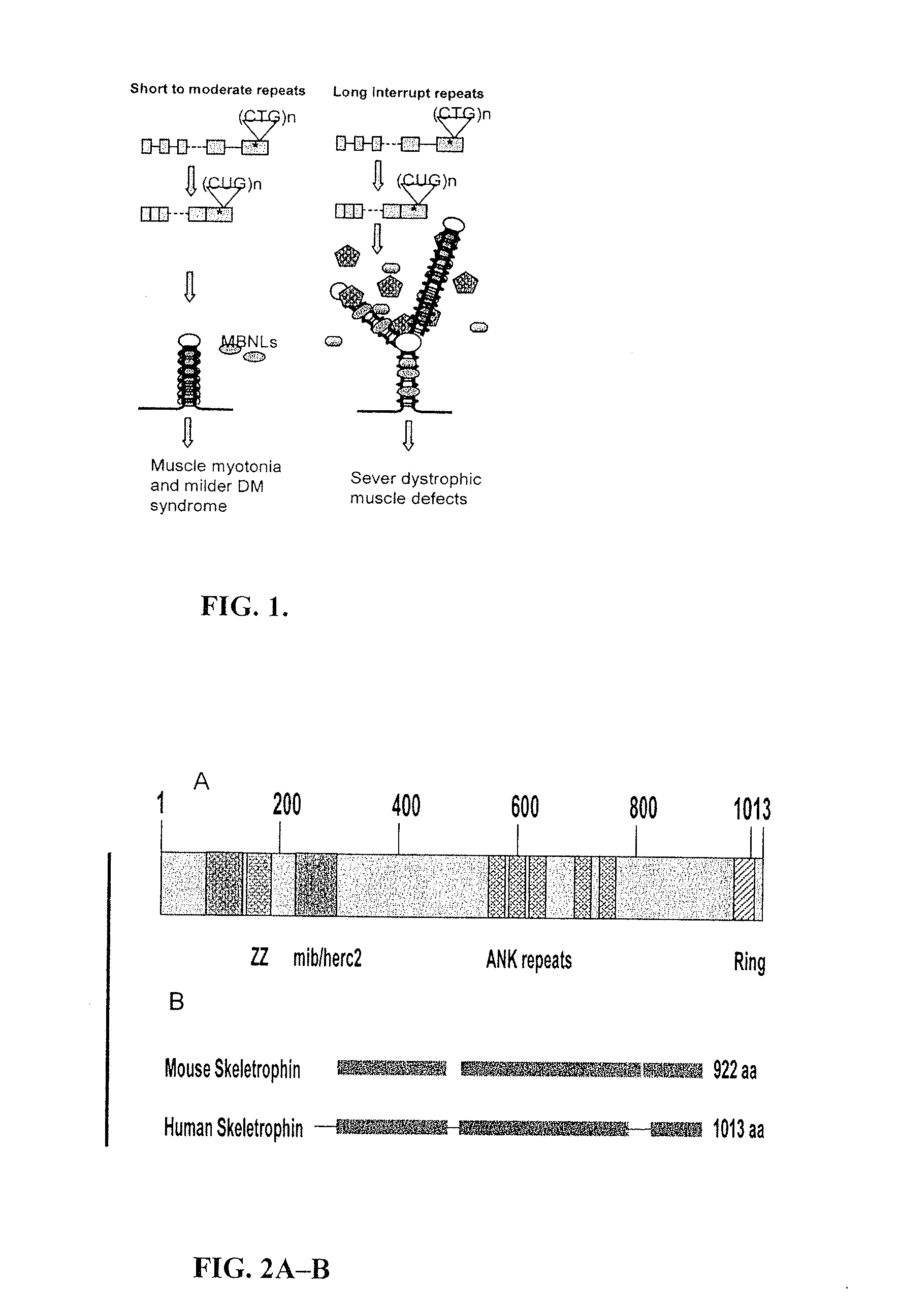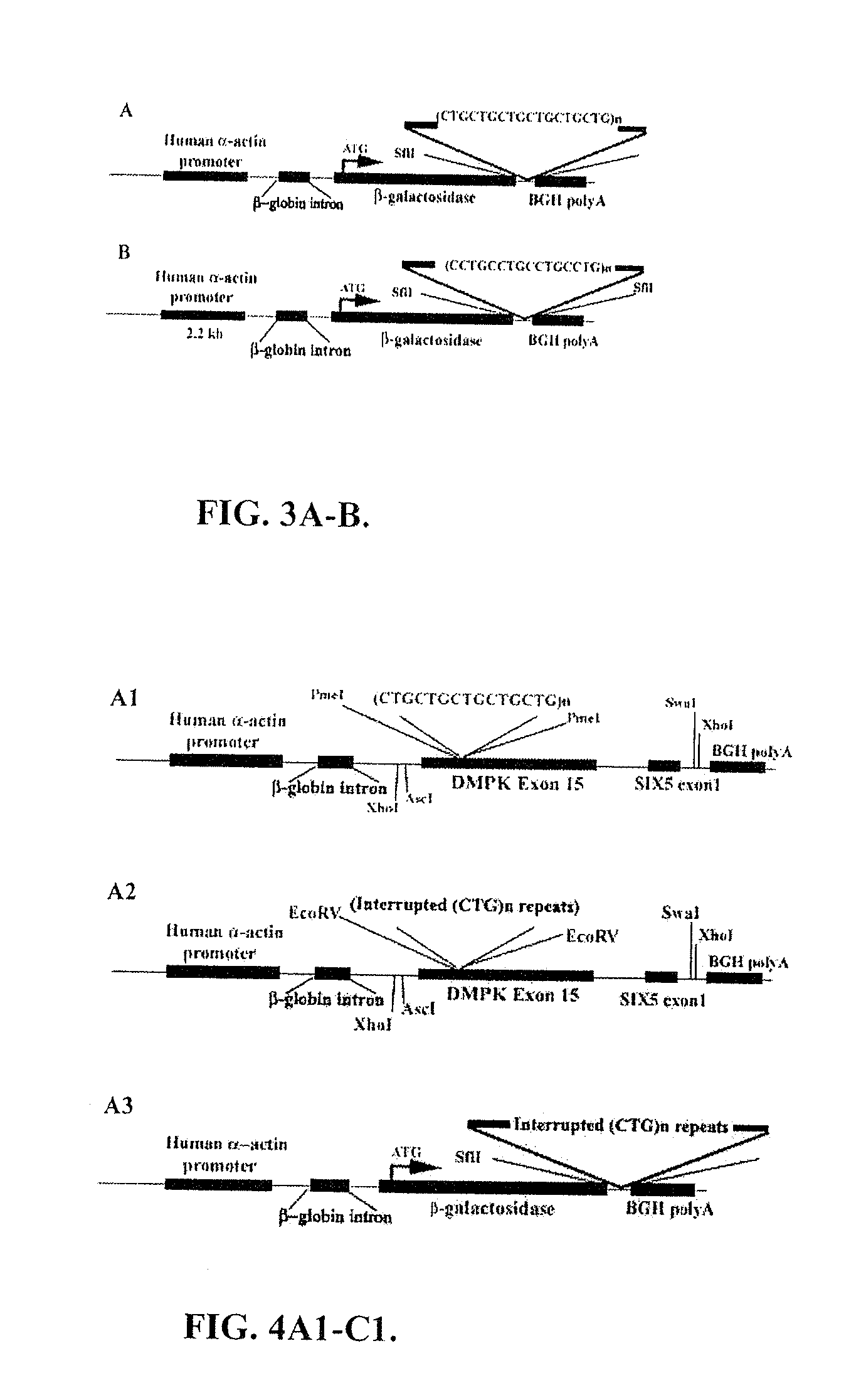Methods and compositions involving nucleotide repeat disorders
a nucleotide repeat and disorder technology, applied in the field of molecular biology and medicine, can solve the problems of severe muscle weakness, degeneration of muscle fibers, and abnormal development of skeletal muscle fibers
- Summary
- Abstract
- Description
- Claims
- Application Information
AI Technical Summary
Benefits of technology
Problems solved by technology
Method used
Image
Examples
example 1
Generation of Constructs of Moderate Expanded CTG (500-700 Repeats) and Longer CTG, CCTG Repeats (>1000) Under T7 Promoter
[0264]In order to generate in vitro transcribed CUG and CCUG RNA, the long CTG, CCTG repeats were placed under the T7 promoter for in vitro transcription of repeats RNA. A unique methodology was developed to clone different length of CTG and CCTG repeat sequences in plasmid DNA and propagate them in bacteria (Sarkar et al., 1998). The 1.5 kb-2.0 kb and >3.0 kb of uninterrupted pure CTG, >4.0 kb of pure CCTG duplexes were ligated into a modified pcDNA3.1 / Hygro(+) (Invitrogen) vector (pSS333) linearized by restriction digested with EcoR V. The ligated product was transformed into E. coli SURE strain (Stratagene) and grown according to the protocol described previously (Sarkar et al., 1998). The resulting clones were digested with Nhe I and PspOMI that flanked the repeat sequences to evaluate the length of cloned repeat sequences.
example 2
Generation of Long (>3 KB) Single-Stranded RNA Encoding CUG and CCUG
[0265]The generation of single-stranded CUG and CCUG RNA repeats is the most important step to achieve the objectives proposed in this study. However, cloning longer repeat sequences has been difficult mainly because the repeat sequences show high degree of instability when grown in bacteria (Hashem et al., 2002a; Hashem et al., 2002b). A unique methodology to clone and stabilize longer CTG and CCTG repeat sequences in bacteria has been developed (Sarkar et al., 1998). Using this methodology, clones of 3 to 5 kb of CTG and CCTG repeats in plasmid DNA can be achieved. A clone of >3 kb of CTG and CCTG repeat in pSS333 to generate plasmid pSS333-CTG and pSS333-CCTG has been produced. These plasmids were designed in a way such that the cloned repeat sequences are flanked by T3 and T7 promoters. The vector encoding larger than 3 kb of CTG and CCTG repeat sequences were linearized with PspOMI and then the biotin-labeled C...
example 3
Identification of Skeletrophin, a Protein Sequestered by Long CUG RNA from Skeletal Muscle
[0267]To identify proteins that are sequestered by expanded CUG RNA, nuclear extracts from skeletal muscle were made using NE-PER Nuclear and Cytoplasmic Extract Reagents (Pierce). Vendor's instructions were followed to obtain protein extracts wherein the native structure and activity of the extracted proteins remain unperturbed. In order to identify the CUG and CCUG RNA binding proteins, the protein extract from muscle was first incubated with the RNA encoding single-stranded but structured CUG RNA. In vitro transcribed long biotin-labeled CUG RNA and control RNA (single-stranded lacZ RNA) was incubated with magnetic beads. Nuclear extracts from mouse skeletal muscle was added to the mixture of biotin labeled RNA and magnetic beads and then incubated at 4° C. for overnight. The unbound proteins were washed by RNA wash buffer. The remaining proteins that are bound with CUG-RNA were eluted out b...
PUM
| Property | Measurement | Unit |
|---|---|---|
| Fraction | aaaaa | aaaaa |
| Length | aaaaa | aaaaa |
| Cell angle | aaaaa | aaaaa |
Abstract
Description
Claims
Application Information
 Login to View More
Login to View More - R&D
- Intellectual Property
- Life Sciences
- Materials
- Tech Scout
- Unparalleled Data Quality
- Higher Quality Content
- 60% Fewer Hallucinations
Browse by: Latest US Patents, China's latest patents, Technical Efficacy Thesaurus, Application Domain, Technology Topic, Popular Technical Reports.
© 2025 PatSnap. All rights reserved.Legal|Privacy policy|Modern Slavery Act Transparency Statement|Sitemap|About US| Contact US: help@patsnap.com



